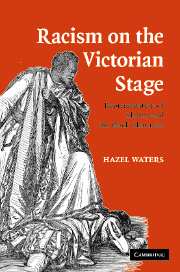Book contents
- Frontmatter
- Contents
- List of illustrations
- Acknowledgements
- Introduction
- 1 From vengeance to sentiment
- 2 The beginning of the end for the black avenger
- 3 Ira Aldridge and the battlefield of race
- 4 The comic and the grotesque: the American influence
- 5 The consolidation of the black grotesque
- 6 Slavery freed from the constraint of blackness
- 7 Uncle Tom – moral high ground or low comedy?
- Afterword
- Notes
- Bibliography
- Index
6 - Slavery freed from the constraint of blackness
Published online by Cambridge University Press: 22 September 2009
- Frontmatter
- Contents
- List of illustrations
- Acknowledgements
- Introduction
- 1 From vengeance to sentiment
- 2 The beginning of the end for the black avenger
- 3 Ira Aldridge and the battlefield of race
- 4 The comic and the grotesque: the American influence
- 5 The consolidation of the black grotesque
- 6 Slavery freed from the constraint of blackness
- 7 Uncle Tom – moral high ground or low comedy?
- Afterword
- Notes
- Bibliography
- Index
Summary
In sum, by the late 1840s serious dramatic intention was scarcely compatible with the black-skinned character, apart from those in the repertoire of Ira Aldridge. The influence of the comic Jim Crow figure, in all its manifestations, was pervasive. It chimed well with a growing belief – apparently evidenced by the continuing economic decline of the sugar industry in the West Indies, following slavery's abolition, and propagandised by the planter interest – that responsibility and freedom were incompatible with a black skin. Thomas Carlyle had expressed this most forcefully, arguing, in effect, for the reintroduction of slavery. The image of the irresponsible, carefree and indolent black was one that, at the popular level, the Crow figure reinforced, though never with the level of vitriol that Carlyle brought to it. The issue of slavery retained currency in other ways – comparisons between the lot of slaves and the lot of the English working class were frequently resorted to – and much attention was focused on the American situation. At the level of cultural expression, the theme of slavery continued to drag in its wake all those other, multilayered notions of the Englishness of liberty and freedom. But what was new was the way in which American quasi-‘scientific’ notions of race came to be filtered down to a wider English public through the agency of the theatre.
It is worth recalling that it was not only the abolitionists or the commentators on American mores who made their way across the Atlantic.
- Type
- Chapter
- Information
- Racism on the Victorian StageRepresentation of Slavery and the Black Character, pp. 130 - 154Publisher: Cambridge University PressPrint publication year: 2007



